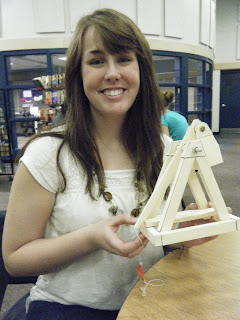Creating the paper trebuchet was relatively easy. There was some slight frustration with the cutting and folding at the start. It was somewhat difficult to know which lines to cut, which lines to fold up, and which lines to fold down. It was also relatively difficult to create an appropriate pouch. It was difficult to create a pouch that held the ball tight enough so that it would not fall out, but not too tight as to prevent the ball from being released.
Air resistance was relatively minimal in operating our paper trebuchet. Air resistance was hard to recognize and did not have a recognizable effect on the flight of our ball. We can, however, know that there was air resistance present.
Gravity played a huge role in our operating our trebuchet. We had to work with gravity to create a trebuchet that released the ball at a point that would created optimal results in both distance and accuracy.
The angle of release on our trebuchet was 45 degrees. This truly optimized the distance our trebuchet hurled the ball. When the angle of release is 45 degrees, a specific relationship exists between the x and y components that shows optimal results in hurling distance.
The counterweight we used for the distance competition was very large. We used approximately 40 individual weights to optimize our distance. When we were concerned with accuracy, we decreased the number of weights weights to 25 weight, which reduced the distance that the ball would go, without compromising the angle of release.
 |
| The trebuchet and myself! |
 |
| Our paper trebuchet! |
No comments:
Post a Comment